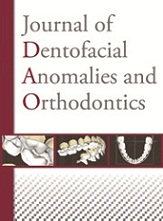No CrossRef data available.
Article contents
A new method for the utilization of cephalometric measurements in orthodontics or how standard deviations can sometimes be the practitioner’s false friends (Part 1)
Published online by Cambridge University Press: 31 May 2011
Abstract
Today there is near universal agreement that the cephalometric analyses presented by the Americans Ricketts, Steiner, and Tweed need to be re-evaluated and brought up to date. To this end, our C.R.A.N.I.O.M group has prepared a new method for using cephalometric numerical and angular readings in the preparation of a reasonable and well-reasoned aid to diagnosis.
We analyzed the data from a sample of 83 young adults with Class I occlusions, none of whom had ever received orthodontic treatment.
In our work the most striking new consideration that we employed was to use the extreme values for each variable of this sample. These figures constitute extreme parameter limits very distant from each other: for example there is a gap of 30° between the most buccally inclined incisor and the most lingually, or palatally, inclined.
Therefore, we found incisor inclination to be acceptable within a range of 78 to 114° to Downs’s mandibular plane on the lower arch and from 97.5 to 130.1° to the Frankfort plane for the upper arch. So in our reasoning there is far less need to reposition these teeth in conformity to an arbitrary cephalometric norm.
And, for the same reason, we find far fewer cases requiring extraction in order to allow orthodontists to achieve results that satisfy abusive standards established by Ricketts, Steiner, and Tweed. The osseous measurements that we report simply describe the forms we observed, none of which constitute anomalies but, instead, describe a particular type.
The C.R.A.N.I.O.M group believes that cephalometric analysis occupies a place in orthodontic record taking that comes after those occupied by esthetics, periodontal status, and muscular balance.
Keywords
- Type
- Research Article
- Information
- Journal of Dentofacial Anomalies and Orthodontics , Volume 13 , Issue 4: Varia , December 2010 , pp. 385 - 400
- Copyright
- © RODF / EDP Sciences
Footnotes
C.R.A.N.I.O.M., January 2010
References
C.R.A.N.I.O.M., January 2010




